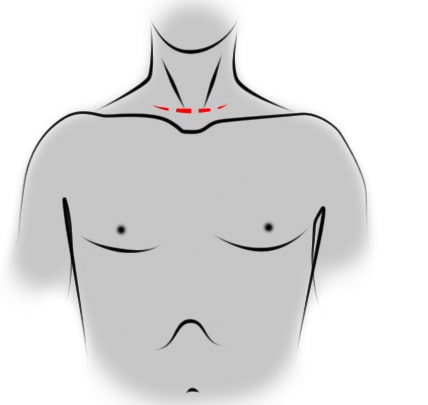Cervicotomy
What is cervicotomy surgery?
 Cervicotomy is an anterior surgical approach to the neck, particularly used for thyroid surgery. It consists of an incision on the front of the neck to access the anatomical structures located in front of the damaged disc. The length of the cervicotomy varies depending on the exposure required for the procedure. It can measure three to four centimeters long for a mediastinoscopy and extend from one sternocleidomastoid muscle to the other and go up along these muscles to the mandible for a U-shaped cervicotomy. Cervicotomy is also used for other surgical procedures, such as cervical discectomy.
Cervicotomy is an anterior surgical approach to the neck, particularly used for thyroid surgery. It consists of an incision on the front of the neck to access the anatomical structures located in front of the damaged disc. The length of the cervicotomy varies depending on the exposure required for the procedure. It can measure three to four centimeters long for a mediastinoscopy and extend from one sternocleidomastoid muscle to the other and go up along these muscles to the mandible for a U-shaped cervicotomy. Cervicotomy is also used for other surgical procedures, such as cervical discectomy.
Who can benefit from this surgery?
Cervicotomy is a surgical procedure that may be required in the following situations:
Thyroid surgery: Cervicotomy is frequently used during thyroid surgery. It provides access to the thyroid, parathyroids and the upper part of the mediastinum.
Cervical discectomy: Cervicotomy can also be used to perform a cervical discectomy. It provides access to the cervical region to remove or treat a herniated disc.
How is the cervicotomy carried out?
Cervicotomy is a surgical procedure consisting of making an incision in the front of the neck to access the anatomical structures located in front of the damaged disc. Here are the general steps of cervicotomy:
Anesthesia: The patient is put to sleep under general anesthesia.
Incision: An incision is made at the front of the neck to access the anatomical structures located in front of the damaged disc.
Exploration: The surgeon explores the anatomical structures in order to identify the anatomical site of the lesion and its origin.
Sampling: It is possible that all or part of the mass may be removed in order to carry out an intraoperative histological examination , thus making it possible to adapt the treatment.
Closing the incisions: The incisions are closed using stitches.
How long does the surgery take?
The duration of cervicotomy may vary depending on each patient and the specific type of surgical procedure. Generally, it lasts around 4 to 5 hours. However, in the case of more complex procedures, it may take longer, and surgical anesthesia of up to 10 hours may be necessary. It is important to discuss the expected duration of the procedure and the recovery time needed with a healthcare professional before making a decision. The length of your hospital stay will be determined based on the nature of your surgery.
What are the risks associated with cervicotomy surgery?
Cervicotomy is a surgical procedure that carries potential risks and complications. Here are some examples of these risks and complications:
Hemorrhage: It is possible to experience bleeding during or after cervicotomy.
Hematoma: A hematoma may form in the surgical area.
Infection: There is a risk of infection after cervicotomy.
Scar separation: The scar may separate after cervicotomy.
Superinfection: Superinfection can occur at the scar.
Neurological risks: Neurological complications may occur, possibly leading to paralysis.
Compressive hematoma: There may be the formation of a compressive hematoma after cervicotomy.
Visible scars: Visible scars may appear after cervicotomy.
What are the surgical consequences?
After a cervicotomy, recommendations for the postoperative period may vary depending on each case and the specific nature of the surgical procedure. Here are some commonly observed guidelines:
Pain management: It is normal to feel pain after a cervicotomy. Pain relievers may be prescribed by the healthcare professional to relieve this pain.
Use of a cervical collar: In some cases, the use of a cervical collar may be necessary to ensure stability of the cervical spine after surgery. Wearing and duration of use of the collar will be determined by the healthcare professional.
Drainage: During surgery, a drainage system may be put in place to remove fluids. This drainage system will usually be removed 24 hours after the operation.
Rest: It is recommended to rest for a period determined by the healthcare professional. Following these recommendations will allow your body to recover effectively.
Physical activities: Demanding physical activities and efforts should be avoided during the recovery period, in order to allow your body to heal properly.
Regular medical follow-up: Regular medical follow-up may be necessary to monitor healing and detect any possible complications. It is important to follow the follow-up appointments recommended by the healthcare professional.